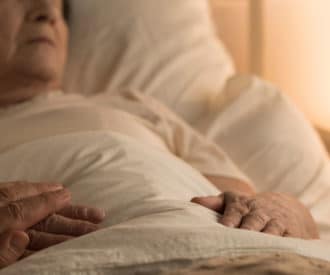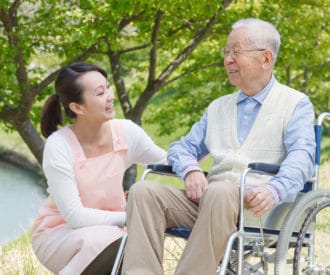
Admitting to bathroom accidents can be tough for seniors. They may try to cover it up by hiding signs of incontinence, which prevents them from getting the help they need to be comfortable, clean, and healthy. Aeroflow Healthcare explains why seniors might hide it and shares 3 tips for recognizing senior incontinence.
Incontinence is a common condition in the United States, affecting over 13 million people and 39% of seniors living in assisted care communities.
Despite how common it is, many seniors with incontinence experience anxiety, shame, and embarrassment – causing them to hide their accidents and avoid getting help.
However, seeking proper solutions allows people to manage the condition, maintain comfort and healthy hygiene, and stay as independent as possible.
That’s why as a caregiver, it helps to understand the emotions behind incontinence and to find out about 3 tips for recognizing top signs of incontinence so seniors won’t have to suffer in silence.
We also share tips on how to offer help and 5 ways that the correct incontinence supplies can help improve the situation.
Why seniors hide incontinence
Many seniors have raised families and cared for others. So, needing help with something so personal can be hard to accept.
They might feel like they’ve lost dignity or independence when they aren’t able to fully control their bladder, especially since accidents can be embarrassing and inconvenient.
Discussing incontinence is considered taboo, so hiding it can feel like one way for seniors to maintain control over the situation.
But this can contribute to health issues like urinary tract infections and prevent them from getting the proper care.
3 tips for recognizing signs of incontinence
Seniors can be very creative when trying to hide incontinence. Some common signs of incontinence to watch for include:
1. Urine smell, soiled clothing, or covered furniture
Smelling urine on clothing is a telltale sign of incontinence.
Another red flag is finding soiled clothing in the laundry hamper or an unusually large amount of laundry.
Another place to check is inside closets and other storage areas – seniors could try to hide soiled clothes instead of throwing them away.
A more subtle sign might be new covers on furniture that could be explained as simply a little redecorating.
But that could be hiding odors or stains so be sure to check underneath. And remember to check their mattress too.
2. Changes in personality or behavior
Seniors with incontinence may become depressed or withdraw and avoid their usual social activities.
They might avoid leaving the house or seeing friends for fear of having an accident in public.
Or they might make an unusual number of trips to the restroom every hour – significantly more than what’s typical for them.
3. Changes in wardrobe
Pay attention to your older adult’s wardrobe to see if anything has changed.
They might wear oversized clothing to absorb accidents or dark clothing to conceal stains. They could carry extra clothes and change several times a day.
If they’re trying to absorb accidents with ill-fitting incontinence products, another sign is unusual bulkiness around their waist or hips.
How to offer help for senior incontinence
Instead of accusing your older adult of covering things up, be someone they can confide in and let them know you’re there to help with anything they need.
Speaking with them one-on-one in a place where they feel comfortable is a non-threatening way to approach the topic.
Initial conversations might end with denials, but it’s important to start the discussion and let them know that you’re there to support them.
In time, they’ll hopefully let you know what kind of help they need.
That gives you the opportunity to suggest speaking with their doctor to find out if the incontinence could be caused by a medical issue or medication side effect. Or, to offer help to find incontinence products that are effective and comfortable.
Note: It’s generally better to avoid using the word “diaper” since that can feel demeaning. Disposable underwear, incontinence briefs, briefs, or pull-ups are more neutral terms that can help prevent embarrassment and reduce resistance to help.
5 ways that finding the correct incontinence supplies can help
Incontinence briefs aren’t a one-size-fits-all product. There are a variety of shapes, sizes, and absorbencies.
Finding the type of disposable underwear that suits your older adult best helps in 5 ways.
1. Increases comfort and style
Correctly-sized briefs will catch leaks to help seniors stay dry and also conceal unpleasant odors.
Plus, today’s modern designs make many pull-ups styles look like regular underwear, with no bulky look or noisy texture.
2. Saves money and reduces potential embarrassment
Seniors can save money by getting their incontinence products covered by health insurance.
As an added bonus, this way, products are shipped directly to their home in discreet packaging.
That eliminates the need to buy incontinence products at local stores and potentially feeling embarrassed by bumping into friends or acquaintances.
3. Gives a feeling of being in control
Incontinence briefs give seniors control over the condition.
This helps with self-esteem at a time when they may be feeling like they’re losing more and more control over their body and their life.
Knowing they won’t have to fear the accidents or leaks that were preventing them from enjoying their usual activities allows them to feel confident and relaxed.
4. Helps with staying clean, dry, and comfortable
Staying dry in an incontinence brief that works well for them means no more sitting in soiled clothes.
The increased comfort and better hygiene also improves health by preventing rashes, infections, and other uncomfortable issues.
5. Increases convenience
Incontinence products also allow seniors to conveniently manage their condition by simply going to the restroom, removing used briefs, and putting on a new pair.
They won’t have to worry about soiled clothing, moisture, or odor. Plus, the clean up is quick and easy.
Recommended for you:
- Incontinence Care: 9 Tips for Caregivers
- 3 Top Benefits of a Daily Routine for Seniors
- 3 Tips to Help You Choose Between Assisted Living vs In Home Care
Guest contributor: Mica Phillips is Director of Urology at Aeroflow Healthcare
This article wasn’t sponsored and doesn’t contain affiliate links. For more information, see How We Make Money.




